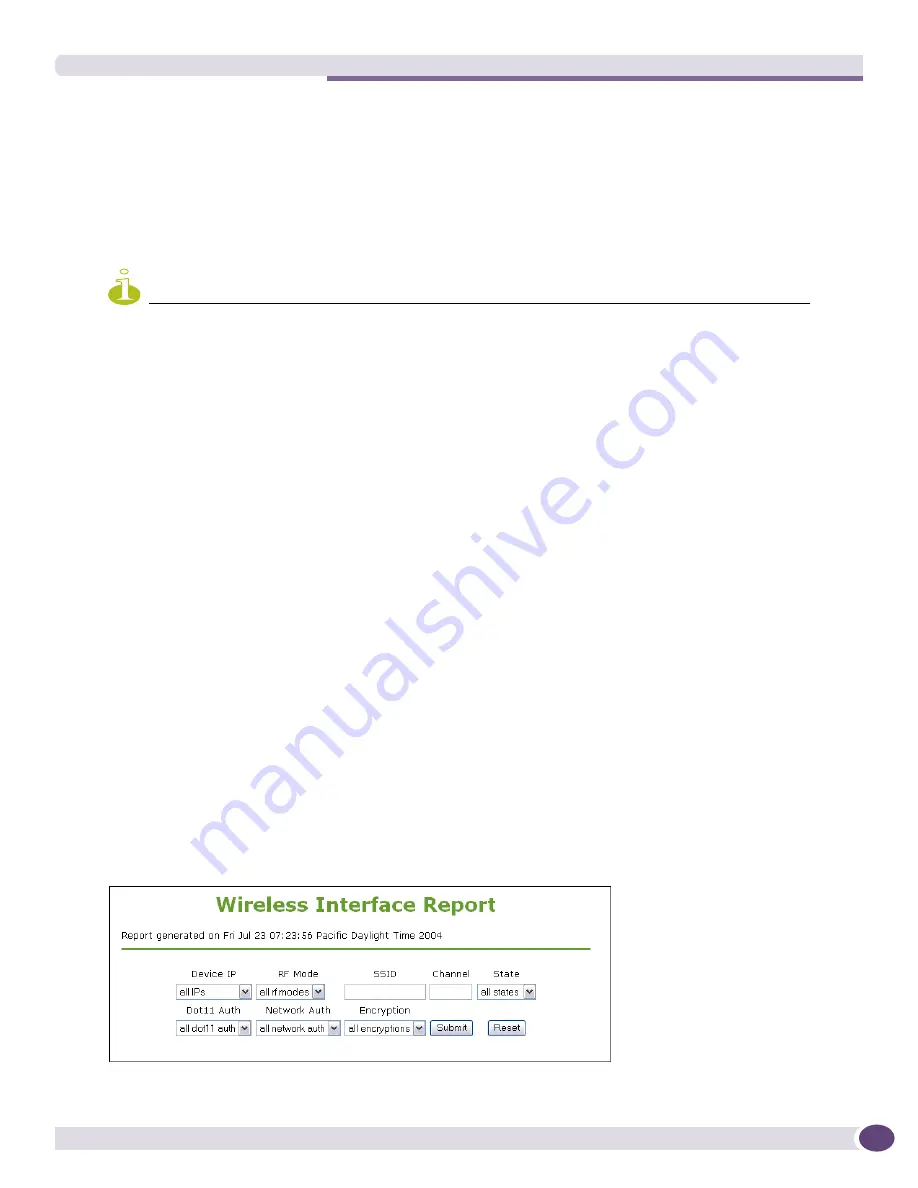
Accessing EPICenter Reports
EPICenter Reference Guide
379
If you have started the Reports feature from within the EPICenter client (with the
Reports
button), you
can use the
Close Window
button to exit the Reports feature.
If you have logged in to the Reports feature directly from a browser, the
Close Window
button is
replaced by a
Logout
button, which returns you to the EPICenter Start-up page.
From the menu at the left on the Reports
Main
page, you can choose a report to view. Click a category
(Devices, Slots and Ports, VLANs, Logs, Wireless Reports
etc.) to see the reports in that category.
NOTE
You can access Online Help for reports by clicking the Help link shown at the top of the EPICenter Reports
Welcome page. You can also access Help for Reports by selecting EPICenter Help from the Help menu in any
EPICenter feature, and then finding the Report you want in the Table of Contents.
The Extreme Networks eSupport Export Report
This report is generated by EPICenter on request, for use by Extreme technical support. It exports
detailed information to a file is csv format. You can then send this report to Extreme.
To create a eSupport report, select a Device Group from the pull-down menu, then click
Export
. You are
asked to provide a filename for the file, and will be able to specify a location on your local system
where the file should be saved.
Using Report Filtering
A number of the reports provide a filtering capability so that you can specify the information you want
in the report. Filtering lets you construct a conditional statement based on the values of relevant
variables in the EPICenter database.
To create a filter, select the values to use in the filter from the drop-down fields provided at the top of
the report. The variables from which you can choose are based on the columns in the report, and will
vary depending on the type of report you are viewing.
In some reports, a field is provided for each column you can use to filter the report results; you select
the value you want to use from the drop-down menu. The Wireless Interface Report is an example of
such a report, as shown in
Figure 179
. The filtering criteria labels match the column headings in the
report.
Figure 179: Report filter specification for the Wireless Interface Report
Summary of Contents for EPICenter 6.0
Page 14: ...EPICenter Reference Guide 14 ...
Page 18: ...Preface EPICenter Reference Guide 18 ...
Page 19: ...1 EPICenter Basic Features ...
Page 20: ......
Page 24: ...EPICenter Overview EPICenter Reference Guide 24 ...
Page 44: ...Getting Started with EPICenter EPICenter Reference Guide 44 ...
Page 100: ...The Inventory Manager EPICenter Reference Guide 100 ...
Page 140: ...The EPICenter Alarm System EPICenter Reference Guide 140 ...
Page 172: ...Configuration Manager EPICenter Reference Guide 172 ...
Page 196: ...The Firmware Manager EPICenter Reference Guide 196 ...
Page 220: ...The Interactive Telnet Feature EPICenter Reference Guide 220 ...
Page 250: ...The Grouping Manager EPICenter Reference Guide 250 ...
Page 276: ...Real Time Statistics EPICenter Reference Guide 276 ...
Page 342: ...Using the VLAN Manager EPICenter Reference Guide 342 ...
Page 348: ...The ESRP Monitor EPICenter Reference Guide 348 ...
Page 446: ...EPICenter Reports EPICenter Reference Guide 446 ...
Page 447: ...2 Advanced Upgrade Features ...
Page 448: ......
Page 480: ...EAPS Protocol Monitoring and Verification EPICenter Reference Guide 480 ...
Page 508: ...Using the Policy Manager EPICenter Reference Guide 508 ...
Page 525: ...3 Appendices ...
Page 526: ......
Page 542: ...EPICenter Backup EPICenter Reference Guide 542 ...
Page 564: ...Voice over IP Manager EPICenter Reference Guide 564 ...
Page 580: ...EPICenter Reference Guide 580 ...






























